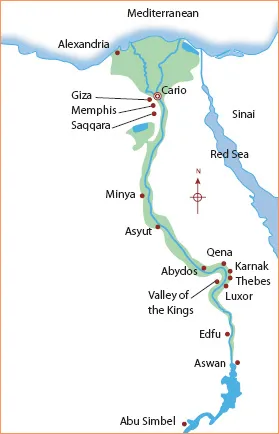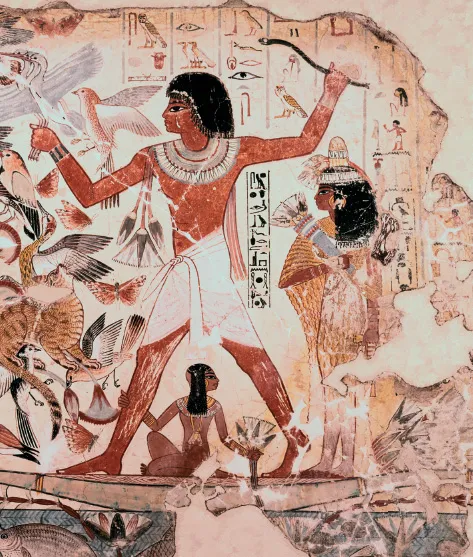
eBook - ePub
Ancient Egypt
David Pickering
This is a test
Condividi libro
- English
- ePUB (disponibile sull'app)
- Disponibile su iOS e Android
eBook - ePub
Ancient Egypt
David Pickering
Dettagli del libro
Anteprima del libro
Indice dei contenuti
Citazioni
Domande frequenti
Come faccio ad annullare l'abbonamento?
È semplicissimo: basta accedere alla sezione Account nelle Impostazioni e cliccare su "Annulla abbonamento". Dopo la cancellazione, l'abbonamento rimarrà attivo per il periodo rimanente già pagato. Per maggiori informazioni, clicca qui
È possibile scaricare libri? Se sì, come?
Al momento è possibile scaricare tramite l'app tutti i nostri libri ePub mobile-friendly. Anche la maggior parte dei nostri PDF è scaricabile e stiamo lavorando per rendere disponibile quanto prima il download di tutti gli altri file. Per maggiori informazioni, clicca qui
Che differenza c'è tra i piani?
Entrambi i piani ti danno accesso illimitato alla libreria e a tutte le funzionalità di Perlego. Le uniche differenze sono il prezzo e il periodo di abbonamento: con il piano annuale risparmierai circa il 30% rispetto a 12 rate con quello mensile.
Cos'è Perlego?
Perlego è un servizio di abbonamento a testi accademici, che ti permette di accedere a un'intera libreria online a un prezzo inferiore rispetto a quello che pagheresti per acquistare un singolo libro al mese. Con oltre 1 milione di testi suddivisi in più di 1.000 categorie, troverai sicuramente ciò che fa per te! Per maggiori informazioni, clicca qui.
Perlego supporta la sintesi vocale?
Cerca l'icona Sintesi vocale nel prossimo libro che leggerai per verificare se è possibile riprodurre l'audio. Questo strumento permette di leggere il testo a voce alta, evidenziandolo man mano che la lettura procede. Puoi aumentare o diminuire la velocità della sintesi vocale, oppure sospendere la riproduzione. Per maggiori informazioni, clicca qui.
Ancient Egypt è disponibile online in formato PDF/ePub?
Sì, puoi accedere a Ancient Egypt di David Pickering in formato PDF e/o ePub, così come ad altri libri molto apprezzati nelle sezioni relative a Histoire e Histoire de l'Égypte antique. Scopri oltre 1 milione di libri disponibili nel nostro catalogo.
Informazioni
Argomento
HistoireCategoria
Histoire de l'Égypte antiquePART ONE
The land of the pharaohs
The emergence of civilization in Egypt depended heavily upon the region’s geographical features. Most important of these was the Nile, the longest river in the world, on the banks of which the first Egyptian settlements and cities evolved and developed.
THE VALLEY OF THE NILE
Little rain falls in the north-west corner of Africa where Egypt is located. Without the River Nile, Egypt would be little more than an uninhabitable hot sandy desert, and there would never have been an ancient Egyptian civilization, which sprang up along its banks.
Many thousands of years ago, Egypt was mainly swampland, but as the climate grew drier the Nile retreated, leaving a strip of fertile soil on both banks. This soil was refreshed each year by the floodwaters that covered the fields with rich black mud in which plants grew readily. The early settlers learned to farm this land and to construct canals and dykes to regulate the flow of water. Towns sprang up along the length of the Nile, the river providing the people with drinking water as well as water for crops.
THE BLACK LAND
The Egyptians called the fertile land on which they built their towns Kemet, meaning ‘black land’. The rest of the country was known as the Red Land. The deserts of the Red Land were very important because they protected the early Egyptians from attacks by neighbouring civilizations, as few armies were willing to cross such desolate waterless wastes.
Sacred river
The ancient Egyptians understood that their lives depended heavily upon the Nile. In their paintings, heaven was often depicted as fertile land surrounded by water.
The waterfalls and rapids of the Nile south of Egypt also hindered invasion from lower down the river. The Egyptians themselves transported their soldiers up or down the Nile to fight off any invaders. The Nile was also vital for trade, providing access to the waters of the Mediterranean Sea in the north and to central Africa in the south.
EGYPT AND THE WORLD
The geographical location of Egypt at the point where Africa meets the Middle East was to prove vital to its development into a great civilization. The natural resources of the region, which included minerals and building stone from the desert as well as crops from the fertile fields beside the Nile, could be transported either by river or across the desert to be traded with neighbouring peoples.
Access to the Mediterranean and to the Red Sea enabled Egyptian merchants sailing out of the Nile to take their goods anywhere in the known world.
EMPIRES OF THE PHARAOHS
With economic development came great wealth and political influence. The physical size of Egypt’s empire varied from age to age, sometimes extended by military conquest – at its greatest extent, it included large parts of northern Africa and Palestine among other neighbouring regions. The relatively close geographical links with the centres of Greek and Roman civilization were particularly important in the later history of ancient Egypt.
Centres of civilization
The most important centres of ancient Egyptian civilization were the traditional capitals of Memphis in the north (including the pyramids at Giza, near modern Cairo) and Thebes in the south (with such associated sites as Karnak, Luxor and the Valley of the Kings). The last capital of ancient Egypt, Alexandria (on the Nile delta in the far north of the country) was not built until the fourth century BC.
Aegyptus to Egypt
The word Egypt is derived from the Greek name for the country: Aegyptus. In Greek mythology, Aegyptus was a descendant of the heifer maiden lo and was the country’s first ruler.
Ancient Egypt


Egyptian civilization was concentrated on the banks of the Nile, from its delta extending 1000km (650 miles) south to Aswan.

Egyptian life
A man and his family hunting wild birds on the River Nile, which was always at the heart of ancient Egyptian civilization.
A man and his family hunting wild birds on the River Nile, which was always at the heart of ancient Egyptian civilization.
PART TWO
The history of ancient Egypt
The civilization of ancient Egypt lasted some 3000 years, longer than any other civilization in world history. At its peak it was remarkable for its cultural, religious and economic achievements. Historians traditionally subdivide this era into a dozen or so periods covering 30 ruling dynasties, beginning around 3000 BC and ending with the Roman invasion in the first century AD.
PREDYNASTIC PERIOD
c. 8000 BC The drying-out of the Sahara caused by a change in the climate, and possibly over-grazing, forces the population to concentrate in the Nile Valley. Egyptian farmers become the first to herd domesticated cattle and other livestock.
c. 6000 BC The first simple single-sailed ships are built. Stone tools are replaced by tools made of metal. Trades include tanning and basket-weaving.
c. 5000 BC Two broadly similar civilizations develop, one in the south of the country (Upper Egypt) and one in the north (Lower Egypt).
c. 4000 BC The first large stone buildings are constructed. Advances are also made in the fields of alchemy, cosmetics, music, medicine and pottery. The building of underground tombs containing grave goods anticipates later burial practices.
c. 3500 BC The Egyptians invent senet, the world’s oldest known board game.
The first people came to Egypt from central Africa some time between 100,000 and 50,000 BC. Archaeological finds suggest that Egypt’s original hunter-gatherers learned to grow grain beside the Nile by 10,000 BC. It was on this prosperous agricultural economy that the country’s later greatness was to depend.
FLINT TOOLS
The first Egyptians belonged to wandering tribes who relied upon the use of flint tools. As the centuries passed they gradually settled in the Nile Valley, living by hunting animals and fishing.
CRAFTS AND TRADE
Around this time the Egyptians also developed skills in using stone, copper, clay, wood and leather and established thriving craft industries. The building of simple papyrus boats promoted links between communities and enabled traders to travel up and down the Nile. Villages and towns sprang up along the length of the river, from the delta in the north to what is now Aswan in the south, each with their own tribal chief, gods, burial customs and artistic styles.
UPPER AND LOWER EGYPT
Little is known about the history of these early kingdoms, though several rulers are known by name, among them Crocodile, Scorpion I, Scorpion II, Iryhor and Ka. The eventual merging of these two kingdoms, which shared a common language an...